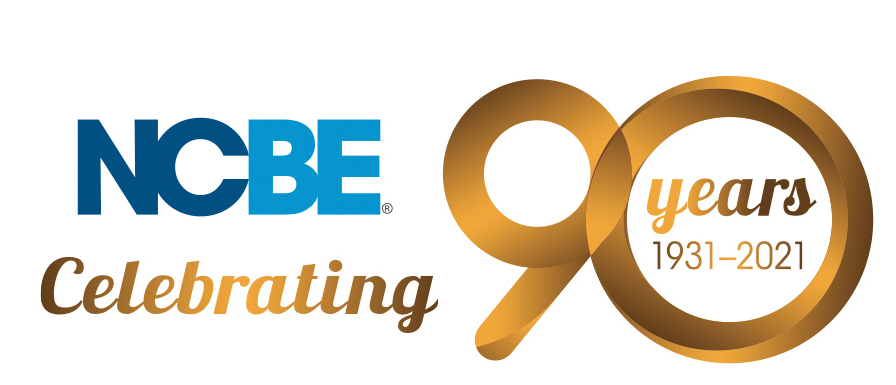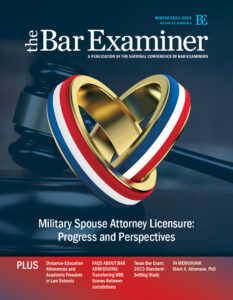This article originally appeared in The Bar Examiner print edition, Winter 2021-2022 (Vol. 90, No. 4), pp. 12–13.

By Penelope J. Gessler
Character and fitness investigations have been at the forefront of NCBE’s work since its inception. A roundtable discussion held at NCBE’s first meeting in September 1931 focused on character examination of candidates as an important element of the overall admissions program.1
When NCBE formally launched its character and fitness investigation service in June 1934, it was “to serve those jurisdictions with fewer applicants, and thus fewer resources to devote to character investigations staff and overhead”2; by 1940, NCBE had already reached the milestone of processing 1,000 character reports for 28 jurisdictions.3
As time went on, discussions continued, and do so to this day—at educational events, in the pages of the Bar Examiner, and beyond—about what to consider when regarding an applicant’s character (and how to appropriately determine it).
For several decades, NCBE processed character and fitness investigations using homegrown jurisdiction applications, performing background investigations using many different variations of character and fitness forms and questions. The need for standardization across jurisdictions eventually became clear.
In the 1990s, NCBE produced a character and fitness application “that [became] ‘the standard’—adopted in whole by many jurisdictions and adopted in part or liberally copied by the remaining jurisdictions, even if they do not use [NCBE’s] investigation services.”4
The standard application was developed to bring more uniformity to the application process. NCBE does not decide which questions a jurisdiction should use on their character applications, but jurisdictions can use the NCBE standard character application as a guide when deciding which questions to include on their own forms, as it reflects the approach that most jurisdictions take. Jurisdictions may (and do) tailor their applications to their specific needs, using standard application questions, revising the standard questions, or eliminating some altogether.
NCBE’s Investigations Department hasn’t rested its laurels since, keeping up with the times while continuing to provide high-level service to jurisdictions. For instance, the character summary report, which is the final product produced from each investigation performed, has evolved and improved over time. Additionally, in 2003 the department transitioned its character report application from paper to an online format and is continuously improving that platform. The latest version of the online character application was released in 2018. This brought several improvements, including:
For applicants:
- More robust error checking
- Ability to copy data from a previously submitted application to a new application
- Ability to upload supporting documentation
- Ability to make amendments online
- Ability to view the status of their application online
For jurisdictions:
- Ability to receive applications electronically, including in data format; resulting character report can be directly imported into their internal case management system
- Ability to receive real-time updates regarding amendments to applications
- Online application has a completion checklist that provides jurisdiction-specific instructions and links to jurisdiction-specific forms
All this ensures jurisdictions and NCBE receive a more complete application.
NCBE’s Investigations Department has become integral to the character and fitness process for many US jurisdictions. NCBE also continues to provide information and guidance to all jurisdictions (regardless of whether they use NCBE investigations services) on best practices for the character and fitness investigations process, via presentations and articles.5
NCBE celebrates its long-standing service to jurisdictions in promoting integrity in admission to the legal profession.
DID YOU KNOW?
NCBE performs background investigations of applicants on behalf of bar admission authorities; however, it has never played a role in deciding whether applicants possess the requisite character and fitness for admission, which is left to the jurisdictions to decide.
History and Progress of the NCBE Character Summary Report
Pre-2003: Summary character report includes many details of every inquiry generated for a specific investigation; average length is 14 pages.
2003: Significant improvements are made to the summary character report: reorganizing the information and making it more concise; average length is 4 pages.
2003: The updated summary character report is first delivered in hard copy form to jurisdictions.
2004: The report is delivered in PDF format via a secure site; jurisdictions receive the completed reports more quickly. The PDF format allows for quick search features; a user can search by specific information within the report.
2009: The report is also available in data format; this allows for data to be directly imported into a jurisdiction’s internal case management system.
2020: The last hard copy of the character summary report is delivered to a jurisdiction; all reports are now delivered in PDF format.
History, Progress, and Standardization of the Character Application
Pre-1997: NCBE processes various character applications from many different jurisdictions; each had its own unique form.
1997: NCBE Standard 97 is created: two versions of the standard character application, one for practicing or soon-to-be admitted attorneys and one for law students.
Some jurisdictions adopt the standard form in various capacities: some use all of the questions and some use a portion of the questions.
2001: NCBE Standard 01 is created; questions are updated and the two Standard 97 applications merged into one form.
The first online version of the character report application is developed, which began as a downloaded software application that required applicants to save their information onto a floppy disk and mail it in with their printed information.
2003: NCBE transitions the character report application from paper and floppy disk to an online modern web application format.
More jurisdictions are added as users of the standard form. The online format allows for more flexibility for creating unique questions. Jurisdictions that don’t use all of the standard questions may require some unique questions to be added to their character applications.
2010: All jurisdictions that use NCBE Investigations services begin using some version of the standard application.
2018: The latest version of the online character application is published, improving applicant experience by including such features as uploading documents and making online amendments.
2020: The last hard copy of a character application is received by NCBE; all applications now arrive in data format using a web application.
2021: Evaluation of the NCBE standard application begins to ensure information collected is necessary and relevant to the assessment of applicant character for the purpose of bar admission, while promoting a fair and equitable process for a diverse applicant population.
Notes
- “Character Examination of Candidates,” 1(3) The Bar Examiner (January 1932) 63–77, at 63. (Go back)
- Chris Christian, “NCBE Character and Fitness Investigations: The Electronic Application and Other Minor Processing Miracles,” 77(1) The Bar Examiner (February 2008) 6–10, at 6. (Go back)
- Marjorie Merritt, “The First Thousand Character Investigations,” 9(1) The Bar Examiner (January 1940) 14–24, at 14. (Go back)
- Penelope J. Gessler and Kellie R. Early, “NCBE’s Character and Fitness Investigations Services: A Look at the Present—A Vision of the Future,” 86(3) The Bar Examiner (September 2017) 26–31, at 27. (Go back)
- See, e.g., Keith Wilkinson, “Mining the Web: Maximizing Internet Tools for Character and Fitness Investigations” 88(3) The Bar Examiner (Fall 2019) 9–16. (Go back)

Penelope J. Gessler is Director of Investigations for the National Conference of Bar Examiners.
Contact us to request a pdf file of the original article as it appeared in the print edition.
[apss_share]






